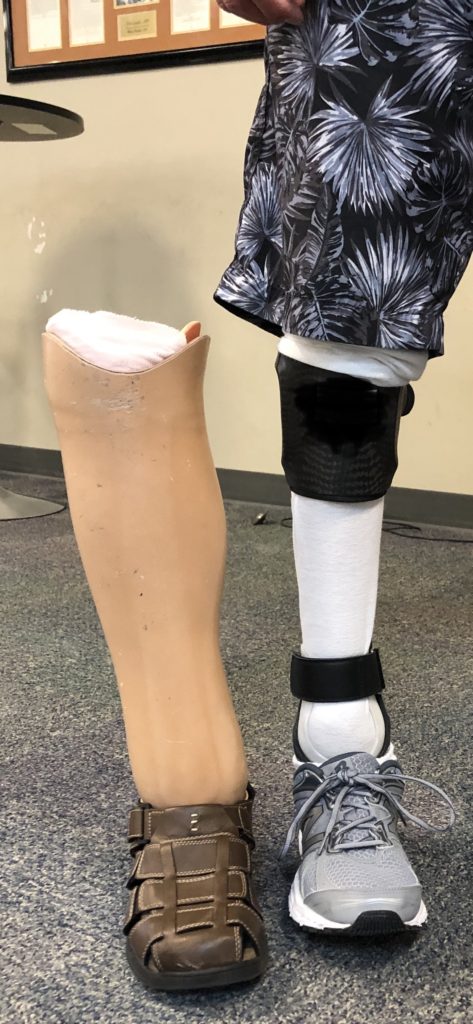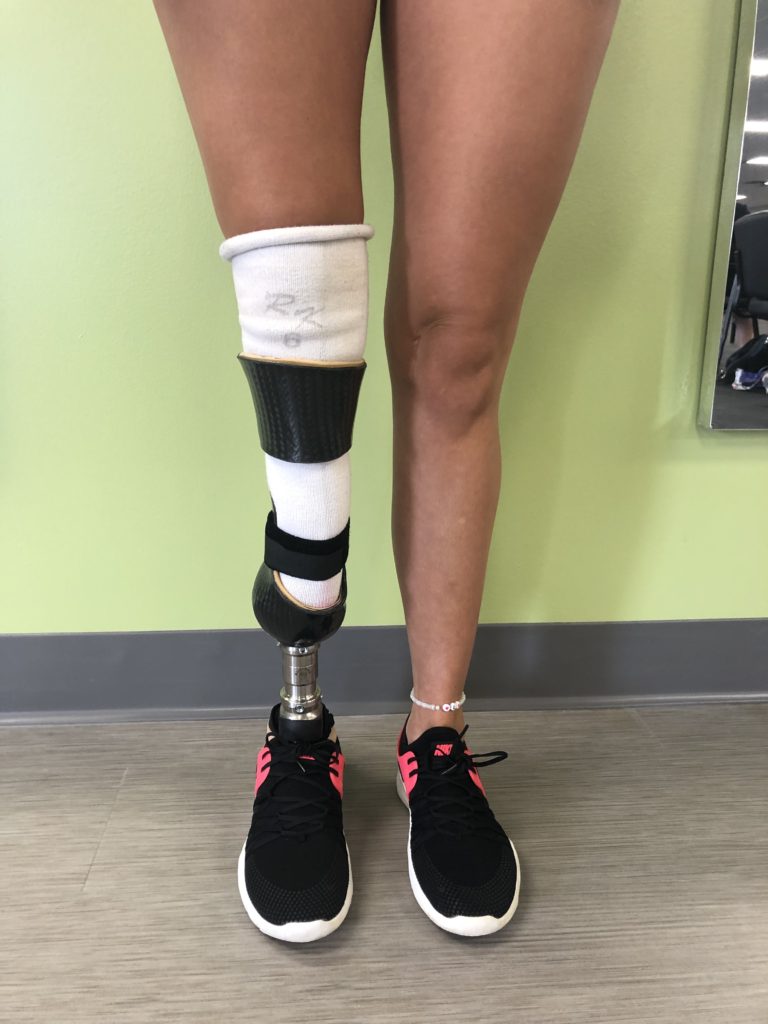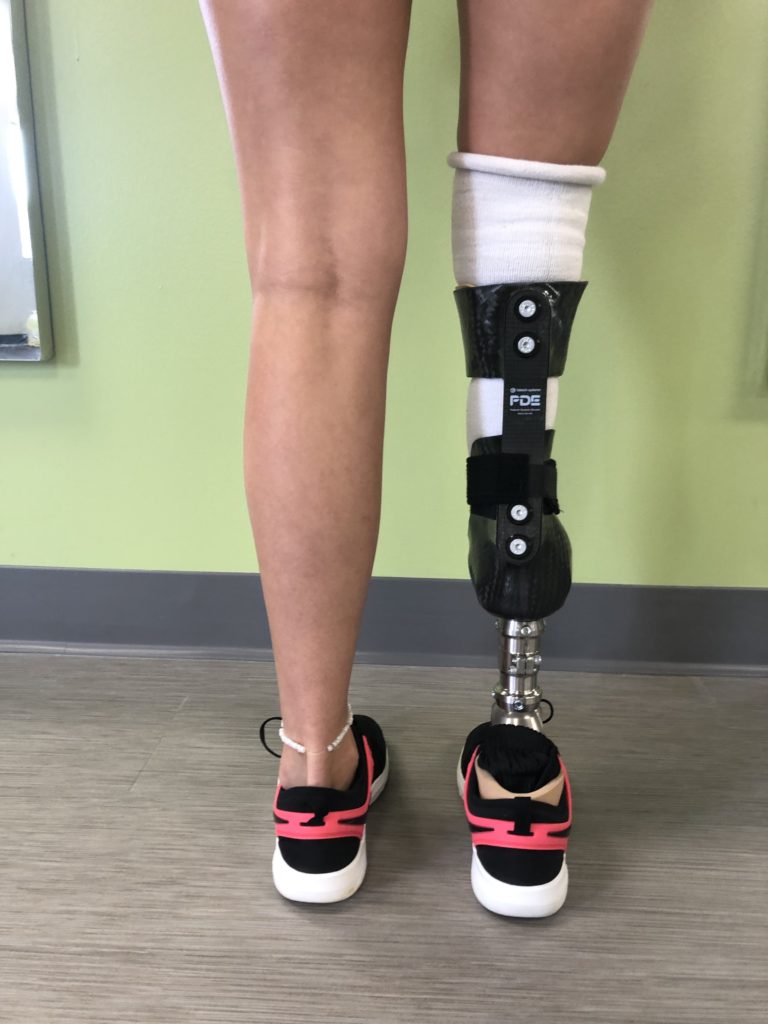
Transtibial Prosthetic System - (Below Knee)

All patients being fit with a transtibial prosthesis are measured and casted for a prosthetic liner made of medical grade silicone. These liners are fabricated on-site in our liner manufacturing lab.
The second component of the transtibial prosthetic system is the prosthetic sock. These socks are layered on top of the liner and act as a wick between the liner and the socket. Socks also accommodate for volume changes within the residual limb.
The residual limb is then placed in the socket and air is evacuated. The socket will either contain a vacuum chamber which has been laminated into the socket, or a one-way expulsion valve, depending on the specific needs of the patient (some longer residual limbs do not require elevated vacuum). Lastly, a sealing sleeve is rolled up to seal against the liner above the socket trim lines.
Another variation of the transtibial socket is the Supra Flex system, which allows lower trim lines and increased flexibility at the knee without sacrificing stability.



The Patterson Propulsion Socket System for Symes (through-knee) and Below-the-Knee Amputees
The Patterson Propulsion Socket system for transtibial prosthetics provides improved comfort, stability, and functionality for individuals with above-knee amputations. Its narrow-profile design, dynamic alignment capabilities, shock absorption, and other features contribute to a more user-friendly and adaptable prosthetic solution. This innovative new design allows the patient to bear weight on the end of their residual limb and utilize their muscles in a way not possible when wearing a traditional prosthetic socket, resulting in a much more natural stride. The carbon fiber strut helps to propel the prosthesis, and the patient is able to control it by firing their muscles, giving them a better awareness of the position and movement of their limb.
Socket Design
Features a two-piece flexible socket system with an attached carbon fiber strut allowing patients to bear weight on the end of their residual limb.
Weight Bearing on Residual Limb
The two-piece flexible socket system allows weight-bearing on the end of the residual limb. This feature may contribute to improved comfort and stability, as well as a more natural weight distribution.
Muscle Utilization
The design of the Patterson Propulsion Socket enables users to utilize their muscles in a way that may not be possible with traditional prosthetic sockets. This could result in a more natural and functional stride, enhancing overall mobility and reducing the effort required during walking.
Enhanced Control
With the carbon fiber strut and the two-piece flexible socket system, users may have better control over the prosthesis. The ability to fire muscles to control movement provides a more intuitive and responsive experience, allowing for a greater awareness of the position and motion of the prosthetic limb.
Natural Stride
The goal of the Patterson Propulsion Socket appears to be achieving a more natural stride for the user. By leveraging the muscles and allowing weight-bearing on the residual limb, individuals may experience a gait that closely mimics natural walking patterns.
Propulsion Assistance
The carbon fiber strut attached to the socket suggests that it plays a role in propelling the prosthesis forward. This feature can aid users in achieving a more energy-efficient and dynamic walking motion.
Increased User Awareness
The design’s emphasis on muscle control and feedback may lead to increased user awareness of the position and movement of their prosthetic limb. This heightened awareness can contribute to improved stability and adaptability in various activities.
Frequently Asked Questions About Transtibial Prosthetics
A Transtibial Prosthesis is a type of artificial limb designed for individuals who have undergone below-knee amputation. It replaces the missing limb and aids in restoring mobility.
The prosthetic limb typically consists of a socket, a pylon, and a foot. The socket fits securely onto the residual limb, providing support, while the pylon and foot mimic the function of the lower leg.
The main components include the socket (custom-fitted to the residual limb), pylon (connecting the socket to the foot), and the foot (designed to provide stability and mimic natural movement).
Benefits include improved mobility, enhanced balance, and the ability to engage in various physical activities. It can also help reduce the impact on the remaining joints and muscles.
The socket is custom-designed to fit the unique shape and contours of the individual’s residual limb. This customization ensures a secure and comfortable fit, enhancing the overall performance of the prosthetic limb.
Yes, there are various types of prosthetic feet available, including energy-storing feet, dynamic response feet, and microprocessor-controlled feet. The choice depends on the user’s activity level, lifestyle, and preferences.
Yes, many individuals with transtibial prostheses participate in sports such as running, swimming, cycling, and more. There are specialized prosthetic designs for different activities to enhance performance and safety.
The lifespan of a prosthetic limb can vary based on factors such as usage, changes in the individual’s health, and advancements in technology. Generally, prosthetic limbs may need replacement or upgrades every 3-5 years.
Challenges can include adapting to a new way of walking, potential discomfort or pressure points, and the need for adjustments as the residual limb changes over time. Proper training and communication with a prosthetist are essential for addressing these challenges.
Yes, transtibial prostheses are designed to be compatible with various types of shoes. Your prosthetist can provide guidance on selecting footwear that complements the prosthetic limb for different activities and occasions.
Many insurance plans cover the cost of transtibial prostheses. It’s important to check with your insurance provider to understand the specific terms and conditions of coverage.
